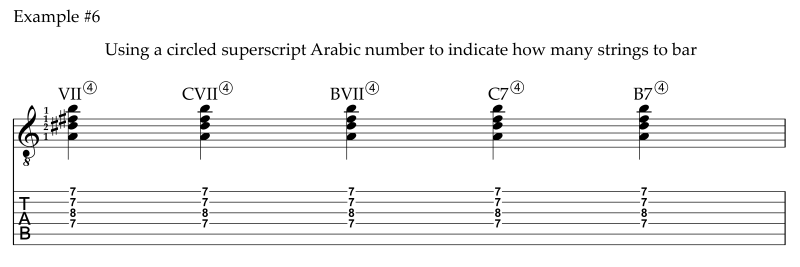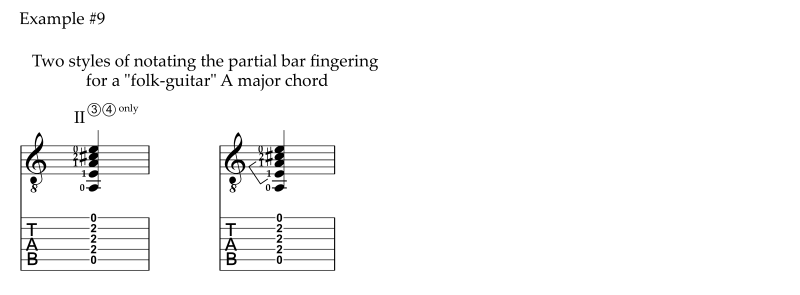The Notation of Bar Chords (or Barre Chords or Barré Chords)

"Douglas who?"
Douglas Niedt is a successful concert and recording artist and highly respected master classical guitar teacher with 50 years of teaching experience. He is Associate Professor of Music (retired), at the Conservatory of Music and Dance, University of Missouri-Kansas City and a Fellow of the Henry W. Bloch School of Management—Regnier Institute for Entrepreneurship and Innovation.
Doug studied with such diverse masters as Andrés Segovia, Pepe Romero, Christopher Parkening, Narciso Yepes, Oscar Ghiglia, and Jorge Morel. Therefore, Doug provides solutions for you from a variety of perspectives and schools of thought.
He gives accurate, reliable advice that has been tested in performance on the concert stage that will work for you at home.
PURCHASE AN ALL-ACCESS PASS
TO THE VAULT OF CLASSICAL GUITAR TECHNIQUE TIPS

"Hello Mr Niedt,
My name's Gretchen, and I'm so happy I purchased an All-Access Pass to the Vault. I love your awesome technique tips. I'm amazed how much I have improved my playing.
Thank you!"
ARE YOU LOOKING FOR PROVEN STRATEGIES
THAT WILL MAKE YOU A BETTER GUITARIST?
Check out the game-changing tips in my Vault—I promise they will kick your playing up to the next level.
Purchase an All-Access Pass to the Vault.
It's a one-time purchase of only $36!
You receive full access to:
- Over 180 technique tips in The Vault.
- Special arrangements of Christmas music
- Arrangement of the beautiful Celtic song, Skellig
- Comprehensive guide, How to Master the Classical Guitar Tremolo
All that for a one-time payment of only $36. Take me to the page to Purchase an All-Access Pass
The Notation of Bar Chords (or Barre Chords or Barré Chords)
By Douglas Niedt
Copyright Douglas Niedt. All Rights Reserved.
This article may be reprinted, but please be considerate and give credit to Douglas Niedt.
Guitarists and editors use the terms bar chord, barre chord, and barré chord interchangeably. “Barré” is the original French spelling which is often printed as “barre” instead (without the accent mark).
How to Notate a Conventional Bar
At the most generic or basic level, a bar chord at the 7th fret may be notated as VII, CVII, BVII, C7, or B7. Example #1:

Roman numerals are usually preferable to Arabic numerals since as in this example, it is easy to confuse the bar notation of C7 or B7 with the C7 chord or B7 chord. Nevertheless, some guitarists and editors use the Arabic number notation.
The letter “C” before the numeral stands for “cejilla” in Spanish or “capotasto” in Italian. The letter “B” before the numeral stands for “bar” in English or “barré” in French.
Some editors use this notation in the widest sense. In other words, any of these could indicate to bar six, five, four, three, or two strings.
To indicate the number of strings to bar with more specificity, some guitarists and editors use fractions before the generic indication. A five-string bar would be indicated with the fraction 5/6, a four-string bar with 2/3, a three-string bar with 1/2, and a two-string bar with 1/3.
In other words, to indicate a bar covering four strings at the 7th fret would be indicated as 2/3VII, 2/3CVII, 2/3BVII, 2/3C7, or 2/3B7. Example #2:

I should mention that some guitarists and editors use the fraction ½ generically to mean anything EXCEPT a full bar. So, it could mean to bar two, three, four, or five strings!
Also, some guitarists and editors use the letters C or B with a line drawn through the center of the letters to indicate a half bar. Example #3:

But once again, it could mean to literally bar three strings or be used to generically indicate to bar two, three, four, or five strings.
Fractions are a little cumbersome, so some guitarists and editors use a superscript Arabic number to the right of the generic indication to indicate how many strings to bar. A bar covering four strings at the 7th fret would be indicated as VII4 CVII4 BVII4 C74 or B74. Example #4:

Or, some guitarists and editors use a subscript Arabic number to the right of the generic indication to indicate how many strings to bar. Using this system, a bar covering four strings at the 7th fret would be indicated as VII4 CVII4 BVII4 C74 or B74. Example #5:

Or, guitarists and editors may use a superscript Arabic circled number to the right of the generic notation to indicate how many strings to bar. Using this system, a bar covering four strings at the 7th fret would be indicated as VII④ CVII④ BVII④ C7④ or B7④. Example #6:

Or, guitarists and editors may use a subscript Arabic circled number to the right of the generic notation to indicate how many strings to bar. Using this system, a bar covering four strings at the 7th fret would be indicated as VII④ CVII④ BVII④ C7④ or B7④. Example #7:

Finally, some guitarists and editors use a solid or dashed line with or without a descending hook end cap to indicate how long to hold the indicated bar. Example #8:

Specialty Bars
How to Notate the Partial Bar
Some guitarists use the term partial bar to refer to a bar of 2, 3, 4, or 5 strings. That makes sense. But when I speak about a partial bar as a specialty bar, I'm talking about a different animal. My definition of a partial bar is when a finger bars two or three adjacent strings, NOT including the string behind it.
A partial bar can bar groups of two strings such as the 3rd and 4th; the 4th and 5th; or the 5th and 6th. Or it can bar groups of three strings such as the 2nd, 3rd, and 4th; the 3rd, 4th, and 5th; or the 4th, 5th, and 6th. And again, the partial bar must allow the string or strings behind it to ring freely.
The partial bar is most often done with the first finger. But if your joints are limber and strong enough, it can also be done with the second, third, or fourth finger.
Again, I use the term partial bar for a bar that covers two or three inner strings. For example, we use a partial bar to play a common A major chord fingered in folk-guitar style. The 1st finger bars only the 3rd and 4th strings. I like to notate these bars with superscript circled numbers indicating exactly which strings we must bar. Others indicate such bars with brackets around the fingers or notes. Example #9:

Using the superscript circled numbers is much clearer than only using brackets. In some pieces, there may be several ways to finger a bar chord. The next example shows the importance of clear notation to communicate to the performer how to play a given bar chord. Example #10:

How to Notate the Hinge Bar
To play a hinge bar, the first string (sometimes also the second string) is fretted by the first finger as if it were a full bar, but the tip of the finger is lifted off the bass strings.
As with other bars, there is no standard notation to indicate a hinge bar. Many guitarists use a lowercase letter “h” to the right of the basic bar notation, others use a small lowercase letter “h” at the upper left, upper right, or lower left or lower right of the basic bar notation. Finally, some guitarists simply write the words “hinge bar” above, to the left, or to the right of the basic bar notation. In these examples, I show the above options using the Roman numeral for the basic bar notation. Example #11:

How to Notate the Cross-Fret Bar, Split Bar, or Diagonal Bar
The cross-fret bar, split bar, or diagonal bar is the most rarely used of the specialty bars. The index finger bars across two consecutive frets simultaneously. Most commonly, the rear of the bar finger holds down the first string and the tip of the bar finger holds down the sixth or fifth string a fret higher.
Again, there is no conventional way to notate this type of bar. I think the most effective way to notate a cross-fret bar is to use two Roman numerals separated by a slash. The first numeral indicates the fret on the 1st string that the rear of the cross-fret bar holds, and the second numeral indicates the fret number of the 5th or 6th string that the tip of the cross-fret bar holds. For greater clarity, it is a good idea to use a circled 5 or circled 6 to indicate which string the bar holds with its fingertip. Adding the words “Cross-Fret Bar,” “Split Bar,” or “Diagonal Bar” also provides greater clarity. Example #12:

